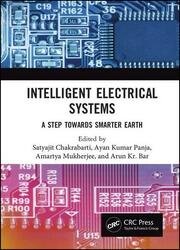 Название: Intelligent Electrical Systems: A Step towards Smarter Earth
Название: Intelligent Electrical Systems: A Step towards Smarter EarthАвтор: Satyajit Chakrabarti, Ayan Kumar Panja
Издательство: CRC Press
Год: 2021
Страниц: 375
Язык: английский
Формат: pdf (true)
Размер: 34.0 MB
The book aims to provide a premier platform for Engineers, researchers, scientists and academicians to present their work in the emerging areas such as Renewable Energy, Energy storage, Power Electronics & drives, Smart devices and communication systems, Artificial Intelligence, Robotics, Networks an IoT, Control and automation etc.
Multilevel inverters (MLI), when used in voltage source inverter, have acquired wide utilization in industries. They are used, to obtain higher-output voltage with less total harmonic reduction (THD) with an increased number of levels. The matrix converter is used for ac to AC converter for variable frequency drives basically giving a good power factor improvement. This chapter aims in developing a simulation model of the matrix converter, established in Matlab Simulink with proper modulation technique. This also deals in controlling a PV-integrated three-phase Cascaded H Bridge (CHB) inverter, loaded with a matrix converter using the proportional resonant (PR) controller and adaptive fuzzy PID controller. The PR controller is helping to remove the steady-state error, and the fuzzy has the advantage of updated PI parameters. The superiority of fuzzy is emphasised based on THD reduction as compared to PR regulator.
The present study focuses on design and analysis of grid-connected PV system under varying irradiance and temperature. The modelling and analysis of the system are carried out in MATLAB/Simulink. The simulated model considers an array of PV panels, with a maximum power of 100.7 kW, connected to a 25 kV medium tension (MT) power utility grid via a DC-DC voltage booster, and a three-level, three-phase DC-AC power converter with natural point clamped (NPC). The maximum power point tracking (MPPT) regulator is implemented in the DC-DC converter using a sub-system block of incremental conductance (InC) algorithm. An efficient control strategy has been considered in inverter for stable operation of the system. An LC filter is also used to remove the harmonics in inverter. The active and reactive powers injected to grid along with grid voltage have been observed. Other parameters such as output voltage and current of PV, DC link voltage, inverter output current, and voltage without filter and after filtering, grid injected voltage and current at point of common coupling (PCC) have been observed.
Reactive power compensation at per level is one of the fundamental operational issues of power systems operation and control. To solve the reactive power compensation problem, the conventional real coded genetic algorithm (RCGA) is customized by the concept of self-adaptation of multivariate q-Gaussian distribution. This is followed by a polynomial mutation approach with arithmetic crossover for optimal control of reactive power in distribution feeders to evade premature convergence with fast rate of convergence. The improved technique has been added to the conventional RCGA. A new combination of crossover and mutation technique has been adopted to get a better route for escaping the local minimum solution. The performance of the algorithm is verified on a sample test system and the better simulation results turn out improved solutions compared to different methods.
In this modern world, the paradigm of smart cities have gathered major popularity. Thanks to the evolution of microcontrollers, the notion of smart city seems more convincing. This study proposes a novel algorithm that helps users to find a free parking space for cars automatically. Microcontrollers like Arduino has already made a huge impact on learning. The widespread affirmation gave a new life to this open source hardware component which potentially became a big challenge to many industrial products and new interests in electronic system and prototyping. The automatic parking system aims to enhance the comfort and safety of driving in constrained environments where much attention and experience are required to steer the car. This paper deals with two major objectives: anautomated parking system and automated vehicle. The first objective is to design a low-cost microcontroller-based model of a car whose working is to park the car by itself when free space is obtained. The second objective is related to automated car parking garage setup. The speciality of the system is the use of efficient low-cost sensors such that the two systems are embedded together working with single power source. The sensors are fixed in the track through which the cars move into the garage or when moving out from the garage.
Скачать Intelligent Electrical Systems: A Step towards Smarter Earth